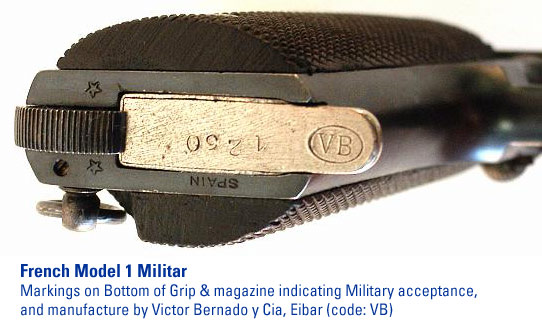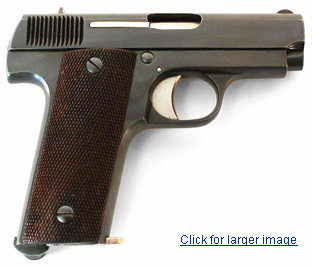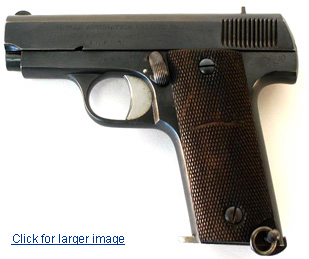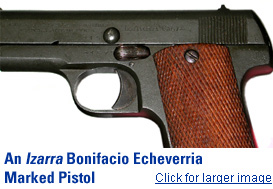Star Firearms — Izarra 'Ruby' Contract Pistols
The "Ruby" styled French contract pistols are atypical of Echeverria pistols of this era. Though interesting in their own right, they are different enough that they are now discussed separately from the parallel Mannlicher derived pistols.
Please note that many early Bonifacio Echeverria pistols were not all even called Stars. The company began using the Izarra (Star in Basque) trade name irregularly until about 1920, when pistols with the Star trade name and logo began to regularly appear.
Bonifacio Echeverria French Contract Model "Ruby" Pistol or Izarra
During World War I, the fierce fighting resulted in the French army (La Grande Guerre) having shortfalls in all sorts of arms. As the available domestic factories were occupied with the production of rifles and machine guns — and some others were under German control — foreign suppliers were instead sought. Since Spain already had an established firearms manufacturing industry, and as right next door but not involved in the war, they were approached immediately.
The French Purchasing Commission selected firm of Gabilondo y Urresti-Eibar and their "Ruby" clone of the FN/Browning Model 1903 pistol in .32 ACP (7.65 mm) caliber. As the contract almost immediately escalated to 30,000 pieces a month, Gabilondo y Urresti subcontracted to a number of other Basque region manufacturers, including Bonifacio Echeverria.
A number of variations were produced, mostly involving minor profile changes. Additionally, a number of different barrel lengths were made. I am not sure if these were requested, or were simply individual subcontractors acting on whim.
Specifications & Operation
The Ruby pistols vary from the Browning 1903 mostly in that the grip safety has been removed. They are simple, straight-blowback pistols, with an internal hammer, and manual safety lever just forward of the left grip panel. To fire, rotate up (clockwise) to the F, or Feu (Fire) position. Grip panels are almost invariably plain checkered wood. The magazine holds 9 shots in the original versions, but some contract variants hold 7 or 8 instead. Magazines are retained by a heel release, rotating about the same pin as the left-side lanyard ring.
Some pistols (including Izarra models I have seen) had a bump on the slide near the safety lever. This is a French mid-stream change to reduce the chance of the safety lever becoming un-applied while holstering.
These pistols were officially issued to Telephonists, Stretcher Bearers, Chauchat (Machine Gun) Gunners along with Loaders, and 37mm Mortar Crew. By 1918 they were also issued to Tank Crewmen.
It is also worth pointing out that there was very poor control of the subcontractors. Though the French authorities inspected all pistols issued, a great many of the same configuration have been sold commercially that were of low quality. Some of these pistols are downright dangerous to the shooter, even with such low-powered cartridges. Use caution when encountering an unknown Ruby style pistol even today; they can even go so far as to fire as soon as loaded. It is my opinion that this quality issue is what led to the reputation even today that Spanish pistols are of low quality.
Manuals & Disassembly Instructions
I do not have manuals for every pistol shown on this site. However, in many cases there is a related manual. Partly to make the series relationships clearer, and partly to assist with speed and accuracy of updating, all manuals can be found in one place, the manuals page. All manuals available are provided as downloadable PDFs, or you may purchase a printed copy of the entire set of handgun manuals.
I have no manual for this pistol, and do not envision obtaining one soon, especially not in english. Therefore, the following is an abbreviated set of instructions for the disassembly of all of the Ruby and similar pistols. This, and much other information in this section, is courtesy of the 151e RIL re-enactors.
- As any time you are servicing or cleaning a firearm, first assure it is unloaded. Pointing the weapon in a safe direction and keeping your finger off the trigger, pull the latch at the rear of the butt to the rear and withdraw the magazine.
- Continuing to keep the weapon pointed in a safe direction, and your finger off the trigger, withdraw the slide fully to the rear. Inspect the chamber for any cartridge that may not have been extracted.
- With the slide fully to the rear, rotate the safety lever (in front of the left grip panel) clockwise until it engages the notch in the slide. Allow this to retain the slide, and release your pressure on it.
- To remove the barrel, rotate it to the right, pull forward, then rotate it left. You may then withdraw it entirely from the slide.
- To remove the slide, then hold the pistol with one hand in a firm firing grip and withdraw the slide, assuring that the safety lever disengages. Let the slide slowly forward, and off the frame.
- The recoil spring may then be easily removed from the barrel.
- If needed, unscrew the grip panels for cleaning or maintenance, using a quality, appropriately sized, hollow-ground screwdriver. Most trigger assembly parts are accessable from the right side. Use caution to not loose any pieces.
Identification:
With so many companies subcontracted to make the Ruby clones, and others doing so without license, there is much confusion as to which is which. To further add to the confusion, most of these companies went out of business, many records were destroyed in the Civil War, and many other changed their name. A number of manufacturers sold their pistols entirely under trade names which did not include the company name.
The following is a list of the most common of many subcontractors to Gabilondo y Urresti for the French service pistols. The list includes manufacturers when known, additional trade names if any are known, and a letter code. The code will appear somewhere, but may only be clear on some obscure location. Do not use the magazine floorplate for identification, as these seem to have been commonly mixed (the floorplate identifier in the photo is accurate, and is shown as its a good photo). Most Izarra (Bonifacio Echeverria) pistols seem to have the I in a circle at the extreme rear of the left side of the frame.
Note that stars on the bottom of the grip denote acceptance by the French military authorities. They have nothing to do with Izarra or Star pistols per. se.

- A: Gaspar Arizaga, Eibar No trade name used
- AA: Azanza y Arrizabalaga, Eibar – "Reims," "Modelo 1916"
- AE: La Armeria Elgoibaresa, Eligobar – "Lusitania"
- AG: Francisco Arizmendi y Goenaga, Eibar – "Ideal," "Roland," "Brunswig"
- AH: Acha Hermanos, Ermunda – Possibly no trade name used – Pistols marked "Looking Glass" seem to be post WWI
- AK: Fabrica de Armas Alkartasuna, SA, Guernica – "Alkar" – "Kapitan"
- AL: Aldezabal y Leturiondo, Eibar – No trade name used
- AZ: Arizmendi, Zulacia y Cia, Eibar – "Cebra" – Some may be overstamped "Beistegui Hermanos"
- BA: Fca – de Bersaluzze, Areito, Aurena y Cia – "Allies"
- BH: Beistegui Hermanos, Eibar – "1914 Model Automatic Pistol"
- CU: Unknown
- CZ: Unknown
- EC: Unknown
- EU: Esperanza y Unceta, Guernica, "Model 191x" (dates from 1914-1916 have been observed), "Astra Patent," "Brunswig Model 1916," "Victory"
- GB: Gregorio Bolumburo, Eibar – "Regent," "Regina," "Gloria"
- GN: Garate, Anitua y Cia, Eibar – "Express," "Danton"
- GU: Gabilondo y Urresti – "Ruby" (Prime contractor)
- HE: Hijos de A – Echeverria, Eibar – "Vesta" (code may also be marked on slide), "Izarro"
- I: Bonifacio Echeverria, Eibar – "Izarra"
- IG: Isidrio Gatzanaga, Eibar – "Destroyer" (safety behind grip), "Indian"
- IO: La Industria Orbea, Eibar – No trade name used
- IS: Iraola y Salaverria y Cia – No trade name used
- JE: Javier Echaniz – "Defender"
- LC: Laplana y Capdevila – Trade names are unknown
- LH: Lasangabaster Hermanos, Eibar – Possibly "Douglas"
- MB: Fa de Martin A – Bascaran, Eibar – "Martian"
- RG: Unknown
- RH: Retolaza Hermanos, Eibar – "Liberty," "Paramount," "Stosel," "Titan," "Titanic," "1914 Model Automatic Pistol"
- V – Fabrica De Armas, Durango "Vencedor"
- VB: Victor Bernado y Cia, Eibar – No trade name used – Some have extended barrels
- VD: Unknown
- ZC: Zulaica y Compania, Eibar – "1914 Model," "Royal," "Vincitor"
Though it can by no means be guaranteed, the poor quality clones referred to above should not have French acceptance marks or manufacturer codes. However, quality commercial variants also will not have the French acceptance marks. If unsure in any way as to the provenance of a pistol, use caution.
Regardless of the original quality of the pistol, these are very old guns, many of which saw service in at least one war. If you intend to shoot a pistol of this era, I urge you to take it to a competent gunsmith for inspection. He will usually be able to tell you if its a wall hanger or still a reliable shooter.


